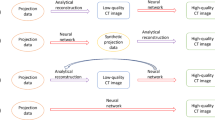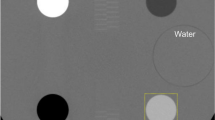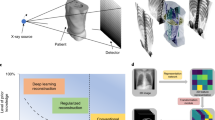Abstract
In pediatric radiology, balancing diagnostic accuracy with reduced radiation exposure is paramount due to the heightened vulnerability of younger patients to radiation. Technological advancements in computed tomography (CT) reconstruction techniques, especially model-based iterative reconstruction and deep learning image reconstruction, have enabled significant reductions in radiation doses without compromising image quality. Deep learning image reconstruction, powered by deep learning algorithms, has demonstrated superiority over traditional techniques like filtered back projection, providing enhanced image quality, especially in pediatric head and cardiac CT scans. Photon-counting detector CT has emerged as another groundbreaking technology, allowing for high-resolution images while substantially reducing radiation doses, proving highly beneficial for pediatric patients requiring frequent imaging. Furthermore, cloud-based dose tracking software focuses on monitoring radiation exposure, ensuring adherence to safety standards. However, the deployment of these technologies presents challenges, including the need for large datasets, computational demands, and potential data privacy issues. This article provides a comprehensive exploration of these technological advancements, their clinical implications, and the ongoing efforts to enhance pediatric radiology’s safety and effectiveness.
Graphical Abstract








Similar content being viewed by others
Data availability
No data was generated in the course of this work.
References
Kutanzi KR, Lumen A, Koturbash I, Miousse IR (2016) Pediatric exposures to ionizing radiation: carcinogenic considerations. Int J Environ Res Public Health 13:1057. https://doi.org/10.3390/ijerph13111057
Nagy E, Tschauner S, Schramek C, Sorantin E (2023) Paediatric CT made easy. Pediatr Radiol 53:581–588. https://doi.org/10.1007/s00247-022-05526-0
Bernhardt P, Lendl M, Deinzer F (2006) New technologies to reduce pediatric radiation doses. Pediatr Radiol 36:212–215. https://doi.org/10.1007/s00247-006-0212-4
Geyer LL, Schoepf UJ, Meinel FG et al (2015) State of the art: iterative CT reconstruction techniques. Radiology 276:339–357. https://doi.org/10.1148/radiol.2015132766
den Harder AM, Willemink MJ, Budde RP et al (2015) Hybrid and model-based iterative reconstruction techniques for pediatric CT. AJR Am J Roentgenol 204:645–653. https://doi.org/10.2214/AJR.14.12590
Gomi T, Sakai R, Goto M et al (2016) Comparison of reconstruction algorithms for decreasing the exposure dose during digital tomosynthesis for arthroplasty: a phantom study. J Digit Imaging 29:488–495. https://doi.org/10.1007/s10278-016-9876-y
Nagayama Y, Sakabe D, Goto M et al (2021) Deep learning-based reconstruction for lower-dose pediatric CT: technical principles, image characteristics, and clinical implementations. Radiographics 41:1936–1953. https://doi.org/10.1148/rg.2021210105
Cao J, Bache S, Schwartz FR, Frush D (2023) Pediatric applications of photon-counting detector CT. AJR Am J Roentgenol 220:580–589. https://doi.org/10.2214/AJR.22.28391
Willemink MJ, Persson M, Pourmorteza A et al (2018) Photon-counting CT: technical principles and clinical prospects. Radiology 289:293–312. https://doi.org/10.1148/radiol.2018172656
Calderoni F, Campanaro F, Colombo PE et al (2019) Analysis of a multicentre cloud-based CT dosimetric database: preliminary results. Eur Radiol Exp 3:27. https://doi.org/10.1186/s41747-019-0105-6
Nagayama Y, Oda S, Nakaura T et al (2018) Radiation dose reduction at pediatric CT: use of low tube voltage and iterative reconstruction. Radiographics 38:1421–1440. https://doi.org/10.1148/rg.2018180041
Willemink MJ, Noel PB (2019) The evolution of image reconstruction for CT-from filtered back projection to artificial intelligence. Eur Radiol 29:2185–2195. https://doi.org/10.1007/s00330-018-5810-7
Atri PK, Sodhi KS, Bhatia A et al (2021) Model-based iterative reconstruction in paediatric head computed tomography: a pilot study on dose reduction in children. Pol J Radiol 86:e504–e510. https://doi.org/10.5114/pjr.2021.108884
Southard RN, Bardo DME, Temkit MH et al (2019) Comparison of iterative model reconstruction versus filtered back-projection in pediatric emergency head CT: dose, image quality, and image-reconstruction times. AJNR Am J Neuroradiol 40:866–871. https://doi.org/10.3174/ajnr.A6034
LeCun Y, Bengio Y, Hinton G (2015) Deep learning. Nature 521:436–444. https://doi.org/10.1038/nature14539
Yamashita R, Nishio M, Do RKG, Togashi K (2018) Convolutional neural networks: an overview and application in radiology. Insights Imaging 9:611–629. https://doi.org/10.1007/s13244-018-0639-9
Battleday RM, Peterson JC, Griffiths TL (2021) From convolutional neural networks to models of higher-level cognition (and back again). Ann N Y Acad Sci 1505:55–78. https://doi.org/10.1111/nyas.14593
Vaishnav JY, Jung WC, Popescu LM et al (2014) Objective assessment of image quality and dose reduction in CT iterative reconstruction. Med Phys 41:071904. https://doi.org/10.1118/1.4881148
Sun J, Li H, Wang B et al (2021) Application of a deep learning image reconstruction (DLIR) algorithm in head CT imaging for children to improve image quality and lesion detection. BMC Med Imaging 21:108. https://doi.org/10.1186/s12880-021-00637-w
Li Y, Liu X, Zhuang XH et al (2022) Assessment of low-dose paranasal sinus CT imaging using a new deep learning image reconstruction technique in children compared to adaptive statistical iterative reconstruction V (ASiR-V). BMC Med Imaging 22:106. https://doi.org/10.1186/s12880-022-00834-1
Hee Kim K, Choo KS, Jin Nam K et al (2022) Cardiac CTA image quality of adaptive statistical iterative reconstruction-V versus deep learning reconstruction “TrueFidelity” in children with congenital heart disease. Medicine (Baltimore) 101:e31169. https://doi.org/10.1097/MD.0000000000031169
Zhang K, Shi X, Xie SS et al (2022) Deep learning image reconstruction in pediatric abdominal and chest computed tomography: a comparison of image quality and radiation dose. Quant Imaging Med Surg 12:3238–3250. https://doi.org/10.21037/qims-21-936
Su B, Wen Y, Liu Y et al (2022) A deep learning method for eliminating head motion artifacts in computed tomography. Med Phys 49:411–419. https://doi.org/10.1002/mp.15354
Han T, Gong X, Feng F et al (2023) Privacy-preserving multi-source domain adaptation for medical data. IEEE J Biomed Health Inform 27:842–853. https://doi.org/10.1109/JBHI.2022.3175071
Thian YL, Ng DW, Hallinan J et al (2022) Effect of training data volume on performance of convolutional neural network pneumothorax classifiers. J Digit Imaging 35:881–892. https://doi.org/10.1007/s10278-022-00594-y
Ghosh A, Jana ND, Mallik S, Zhao Z (2022) Designing optimal convolutional neural network architecture using differential evolution algorithm. Patterns (N Y) 3:100567. https://doi.org/10.1016/j.patter.2022.100567
Zech JR, Badgeley MA, Liu M et al (2018) Variable generalization performance of a deep learning model to detect pneumonia in chest radiographs: a cross-sectional study. PLoS Med 15:e1002683. https://doi.org/10.1371/journal.pmed.1002683
Gerke S, Yeung S, Cohen IG (2020) Ethical and legal aspects of ambient intelligence in hospitals. JAMA 323:601–602. https://doi.org/10.1001/jama.2019.21699
Bartlett DJ, Koo CW, Bartholmai BJ et al (2019) High-resolution chest computed tomography imaging of the lungs: impact of 1024 matrix reconstruction and photon-counting detector computed tomography. Invest Radiol 54:129–137. https://doi.org/10.1097/RLI.0000000000000524
Understanding the technology behind photon-counting CT. https://www.siemens-healthineers.com/tr/computed-tomography/technologies-and-innovations/photon-counting-ct. Accessed 12 November 2023
Tsiflikas I, Thater G, Ayx I et al (2023) Low dose pediatric chest computed tomography on a photon counting detector system - initial clinical experience. Pediatr Radiol 53:1057–1062. https://doi.org/10.1007/s00247-022-05584-4
Horst KK, Yu L, McCollough CH et al (2023) Potential benefits of photon counting detector computed tomography in pediatric imaging. Br J Radiol. https://doi.org/10.1259/bjr.20230189
Esquivel A, Ferrero A, Mileto A et al (2022) Photon-counting detector CT: key points radiologists should know. Korean J Radiol 23:854–865. https://doi.org/10.3348/kjr.2022.0377
Sandfort V, Persson M, Pourmorteza A et al (2021) Spectral photon-counting CT in cardiovascular imaging. J Cardiovasc Comput Tomogr 15:218–225. https://doi.org/10.1016/j.jcct.2020.12.005
Rajendran K, Voss BA, Zhou W et al (2020) Dose reduction for sinus and temporal bone imaging using photon-counting detector CT with an additional tin filter. Invest Radiol 55:91–100. https://doi.org/10.1097/RLI.0000000000000614
Tao S, Rajendran K, McCollough CH, Leng S (2019) Feasibility of multi-contrast imaging on dual-source photon counting detector (PCD) CT: an initial phantom study. Med Phys 46:4105–4115. https://doi.org/10.1002/mp.13668
Fletcher JG (2023) Photon-counting CT: where can it make an impact on patient care? KCR 2023. https://www.kcr4u.org/upload_data/invited_lecture/20230809095159_23.pdf. Accessed 12 November 2023
Mese I (2023) The potential for photon-counting computed tomography and deep learning to reduce radiation dose in paediatric radiology: reply to et al. Pediatr Radiol 53:1726–1727. https://doi.org/10.1007/s00247-023-05684-9
De Bondt T, Mulkens T, Zanca F et al (2017) Benchmarking pediatric cranial CT protocols using a dose tracking software system: a multicenter study. Eur Radiol 27:841–850. https://doi.org/10.1007/s00330-016-4385-4
MacGregor K, Li I, Dowdell T, Gray BG (2015) Identifying institutional diagnostic reference levels for CT with radiation dose index monitoring software. Radiology 276:507–517. https://doi.org/10.1148/radiol.2015141520
Foley SJ, McEntee MF, Rainford LA (2012) Establishment of CT diagnostic reference levels in Ireland. Br J Radiol 85:1390–1397. https://doi.org/10.1259/bjr/15839549
van der Molen AJ, Schilham A, Stoop P et al (2013) A national survey on radiation dose in CT in The Netherlands. Insights Imag 4:383–390. https://doi.org/10.1007/s13244-013-0253-9
Remedios D, Hierath M, Ashford N et al (2014) Imaging referral guidelines in Europe: now and in the future-EC Referral Guidelines Workshop Proceedings. Insights Imag 5:9–13. https://doi.org/10.1007/s13244-013-0299-8
Remedios D, Hierath M, Ashford N et al (2014) European survey on imaging referral guidelines. Insights Imag 5:15–23. https://doi.org/10.1007/s13244-013-0300-6
Liang CR, Chen PXH, Kapur J et al (2017) Establishment of institutional diagnostic reference level for computed tomography with automated dose-tracking software. J Med Radiat Sci 64:82–89. https://doi.org/10.1002/jmrs.210
American College of Radiology (2018) National Radiology Data Registry (NRDR). American College of Radiology’s Dose Index Registry (DIR) website. https://nrdrsupport.acr.org/support/solutions/articles/11000028993. Accessed 12 November 2023
Parakh A, Euler A, Szucs-Farkas Z, Schindera ST (2017) Transatlantic comparison of CT radiation doses in the era of radiation dose–tracking software. AJR Am J Roentgenol 209:1302–1307. https://doi.org/10.2214/AJR.17.18087
Boos J, Meineke A, Rubbert C et al (2016) Cloud-based CT dose monitoring using the DICOM structured report: fully automated analysis in regard to national diagnostic reference levels. Rofo 188:288–294. https://doi.org/10.1055/s-0041-108059
Cloud-based solution for patient radiation dose monitoring. https://medical.sectra.com/product/sectra-dosetrack. Accessed 17 November 2023
Cook TS, Zimmerman SL, Steingall SR et al (2011) RADIANCE: an automated, enterprise-wide solution for archiving and reporting CT radiation dose estimates. Radiographics 31:1833–1846. https://doi.org/10.1148/rg.317115048
Author information
Authors and Affiliations
Contributions
I.M. and Y.A. conceptualized the idea for this review. I.M., Y.A., and C. A.-M. performed the literature search and data analysis. I.M., Y.A., C. A.-M., and U.D. were instrumental in drafting and critically revising the work. All authors approved the final manuscript.
Corresponding author
Ethics declarations
Conflicts of interest
None
Additional information
Publisher's Note
Springer Nature remains neutral with regard to jurisdictional claims in published maps and institutional affiliations.
Rights and permissions
Springer Nature or its licensor (e.g. a society or other partner) holds exclusive rights to this article under a publishing agreement with the author(s) or other rightsholder(s); author self-archiving of the accepted manuscript version of this article is solely governed by the terms of such publishing agreement and applicable law.
About this article
Cite this article
Mese, I., Altintas Mese, C., Demirsoy, U. et al. Innovative advances in pediatric radiology: computed tomography reconstruction techniques, photon-counting detector computed tomography, and beyond. Pediatr Radiol 54, 1–11 (2024). https://doi.org/10.1007/s00247-023-05823-2
Received:
Revised:
Accepted:
Published:
Issue Date:
DOI: https://doi.org/10.1007/s00247-023-05823-2




